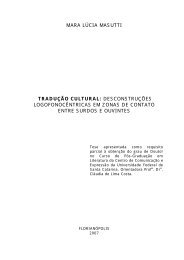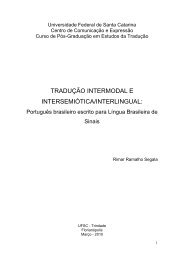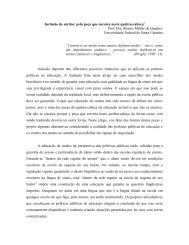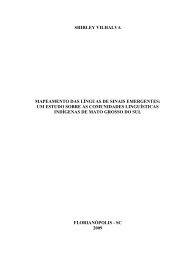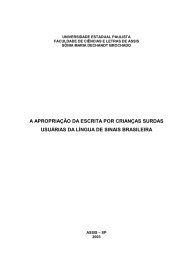Phrase Structure of Brazilian Sign Language - Ronice.cce.prof.ufsc.br
Phrase Structure of Brazilian Sign Language - Ronice.cce.prof.ufsc.br
Phrase Structure of Brazilian Sign Language - Ronice.cce.prof.ufsc.br
Create successful ePaper yourself
Turn your PDF publications into a flip-book with our unique Google optimized e-Paper software.
Braze, 1997; Fischer, 1975; Padden, 1990; Liddell 1980; Aarons, 1994; Lillo-Martin,<<strong>br</strong> />
1986). The conclusions <strong>of</strong> these studies <strong>of</strong> ASL include the following topics:<<strong>br</strong> />
• SVO is the underlying word order in ASL;<<strong>br</strong> />
• SOV order seems to follow from object shift because <strong>of</strong> the presence <strong>of</strong> handling<<strong>br</strong> />
verbs (Chen, 1998), aspectual verbs (Matsuoka, 1997; Braze, 1997), and<<strong>br</strong> />
agreement (Fischer, 1975); there are also special spatial-plain verbs with<<strong>br</strong> />
‘clitics’ and the possibility <strong>of</strong> analyzing a single case <strong>of</strong> SOV as consisting <strong>of</strong><<strong>br</strong> />
three sentences instead <strong>of</strong> one (Padden, 1990);<<strong>br</strong> />
• OSV order follows from topicalization (Fischer 1975; Liddell 1980, Aarons,<<strong>br</strong> />
1994); object shift because <strong>of</strong> the presence <strong>of</strong> handling verbs (Chen, 1998) and<<strong>br</strong> />
aspectual verbs (Matsuoka, 1997; Braze, 1997);<<strong>br</strong> />
• (S)V(O) order follows from possible null arguments, because ASL is a pro-drop<<strong>br</strong> />
language (Lillo-Martin, 1986) 3 .<<strong>br</strong> />
I will consider some <strong>of</strong> these phenomena, since LSB shows OSV and<<strong>br</strong> />
SOV word orders besides SVO word order. The following facts give support to<<strong>br</strong> />
assume that SVO word order is the underlying order in LSB:<<strong>br</strong> />
(i) All SVO sentences are grammatical;<<strong>br</strong> />
(1) a) ______________eg<<strong>br</strong> />
JOHNa aWATCHb bTV (SVO)<<strong>br</strong> />
John watches TV.<<strong>br</strong> />
b) JOHN LIKE SOCCER (SVO)<<strong>br</strong> />
John likes so<strong>cce</strong>r.<<strong>br</strong> />
Sentences like (1) are very natural in LSB and examples using this<<strong>br</strong> />
order are always considered grammatical.<<strong>br</strong> />
The (a) example from (1) has agreement signed on the verb. Also, this<<strong>br</strong> />
example has in common the special non-manual marker that is associated with the<<strong>br</strong> />
subject and object <strong>of</strong> the sentence. We see body shift and eyegaze toward the object<<strong>br</strong> />
from the subject. Eyegaze is marked in the glosses by the line over the sentence. It is<<strong>br</strong> />
important to clarify that it is possible to have other non-manual markers associated<<strong>br</strong> />
with each sentence. For example, head nod can be simultaneously associated with<<strong>br</strong> />
this example sentence. However, these other non-manuals are not obligatory. For our<<strong>br</strong> />
purpose, we are considering only eyegaze and body shift with non-plain verbs.<<strong>br</strong> />
This special non-manual marker that can combine eyegaze and body<<strong>br</strong> />
shift was first described by Bahan (1996) for ASL agreement non-manual markers.<<strong>br</strong> />
He observed that this non-manual marker cooccurs with the whole sentence when<<strong>br</strong> />
agreement is signed, while it is optional with sentences where no agreement is<<strong>br</strong> />
signed. It is interesting to analyze this special non-manual marker because it seems<<strong>br</strong> />
to behave similarly in LSB being associated with the asymmetry between plain and<<strong>br</strong> />
non-plain verbs discussed latter. Agreement together with the non-manual marker<<strong>br</strong> />
seems to be important for the occurrence <strong>of</strong> changes in the basic structure. It seems<<strong>br</strong> />
to have something to do with the information in the verb that licenses different<<strong>br</strong> />
3 Lillo-Martin (1986, 1991) shows that ASL is a pro-drop language and allows null subjects as well as<<strong>br</strong> />
null objects. In LSB, we observe the same distribution (Quadros, 1995).<<strong>br</strong> />
1



